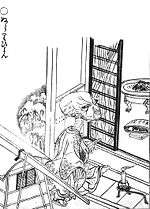Nurarihyon

Nurarihyon (ぬらりひょん, alternatively 滑瓢), or Nūrihyon (ぬうりひょん), is a Japanese Yōkai said to originate from Wakayama Prefecture. It is speculated that the original name used was Nūrihyon, with Nurarihyon being a misreading that got perpetuated.[1][2]
Etymology
The name Nurarihyon is a portmanteau of the words "Nurari" (Japanese: ぬらり or 滑) meaning "to slip away" and "hyon" (Japanese: ひょん or 瓢), an onomatopoeia used to describe something floating upwards. In the name, the sound "hyon" is represented by the character for "gourd".[3] The Nurarihyon is unrelated to another, similarly named ocean Yōkai from Okayama Prefecture.[4]
Appearance and behaviour

The Nurarihyon is usually depicted as an old man with a gourd-shaped head and wearing a kesa.[3]
The Nurarihyon is often depicted sneaking into people's houses while they are away, drinking their tea, and acting as if it is their own house.[4][5] However, this depiction is not one based in folklore, but one based on hearsay and repeated in popular Yōkai media.[4][6] Nurarihyon is also said to be leading the night parade of a 100 demons. Often depicted as a weak yokai in appearance Nurarihyon is actually one of the strongest and most respected yokai.
In popular culture
The Nurarihyon has become quite popular in contemporary Yōkai media, particularly due to the fact that its lack of a concrete background leaves it open to interpretation.[4]
Notes
- ↑ Murakami 2000, p. 255.
- ↑ Kyōgoku & Tada 2000, p. 149-150.
- 1 2 Meyer 2013, p. "Nurarihyon".
- 1 2 3 4 Foster & Kijin 2014, p. 218.
- ↑ Mizuki 1994, p. 344-345.
- ↑ Kyōgoku & Tada 2000, p. 149.
References
- Davisson, Zack (March 2015). "Back Matter: Nurarihyon". Wayward Volume One: String Theory. Image Comics. ISBN 978-1-63215-173-5.
- Foster, Michael Dylan; Kijin, Shinonome (2014). The Book of Yōkai: Mysterious Creatures of Japanese Folklore. University of California Press. ISBN 9780520271029.
- Kyōgoku, Natsuhiko; Tada, Katsumi (2000). Yōkai Zukan. Kokusho Kankōkai. ISBN 4336041873.
- Meyer, Matthew (2013). "Nurarihyon". yokai.com. Retrieved 22 May 2016.
- Mizuki, Shigeru (1994). Zusetsu Nihon Yōkai Taizen. Kōdansha. ISBN 9784062776028.
- Murakami, Kenji (2000). Yōkai Jiten. Mainichi Shinbunsha. ISBN 4620314285.
See also
External links
| Wikimedia Commons has media related to Yuki-onna. |
- Nurarihyon – The Slippery Gourd at hyakumonogatari.com (English).
- Nurarihyon from Yōkai on Mizuki Shigeru Road: Sakaiminato Sightseeing Guide (Japanese)
